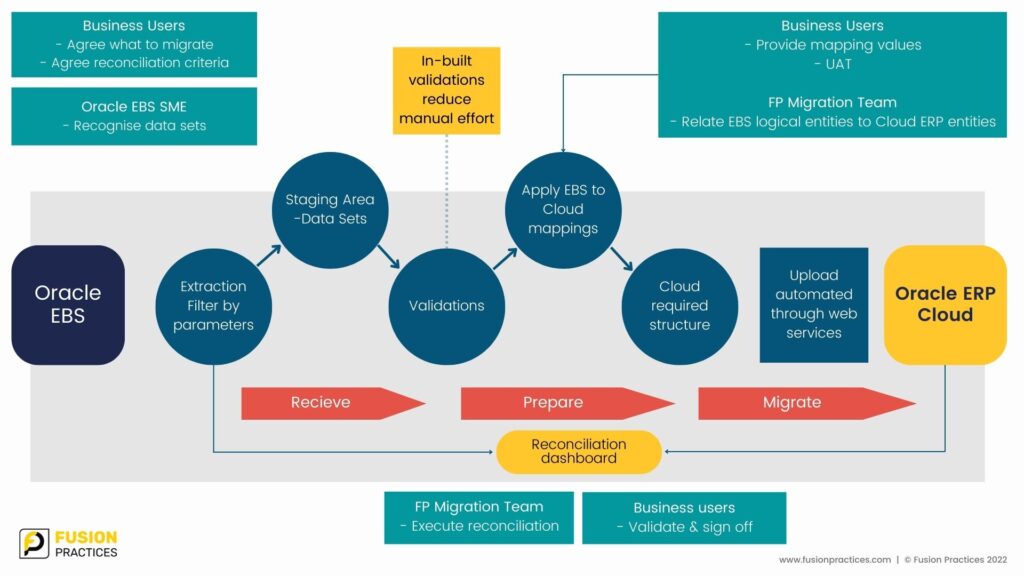Very often we are asked – how much data should we migrate to Oracle Cloud ERP? and what tools exist within Oracle Cloud that makes it easier for the customer themselves to migrate their data? At Fusion Practices we have our own product toolkit that allows for data migration from Oracle EBS to Oracle Cloud ERP, however, this does not stop the customer from doing migration themselves if they are constrained on budgets. Regardless of who performs the data migration the scope for migration is always a hot topic of discussion in projects that we deliver. In this article, we have explained the approach for how you can simplify the scope for data migration from Oracle EBS to Oracle Cloud ERP.
Common needs for migrating from EBS to Cloud are:
- Migrating core financial applications from Oracle E-Business suite onto Oracle ERP Cloud.
- Extracting data from the live, on-premise EBS R12 database, and migrating this into the new version of the Oracle Financials Fusion applications.
- Mapping data from ‘legacy’ to ‘target’ data model, and involves a transformation in the process.
- Loading data using automation and producing reports to help reconcile the dataset.
Typical challenges faced based on experience are:
- Volumes involving millions of lines negated the possibility of extracting data on excel and migrating to Oracle
- Humongous landscape comprising journals, balances, purchase orders and invoices, receipts, budgets and actuals, Project costs etc.
- Interdependent data modules
- Master data included but was not limited to suppliers and customers, so the cleansing of existing data across all these areas was essential
- Decision on data archival – Number of years of data to be migrated to the cloud, data to be archived for Audit and reference
We successfully resolved these challenges for our clients by deploying our end-to-end automated Oracle Cloud ERP data migration solution. To quote an example,
“Fusion Practices completed the first iteration of data migration (100% data) from Oracle EBS to Oracle Cloud Financials at one of the leading banks in the UK comprising 11 General ledgers in just six weeks”
Data Migration Objectives
- Deliver data from Oracle EBS to Oracle ERP Cloud platform in accordance with requirements, in a manner that can be repeated and re-used from environment to environment
- Deliver data from EBS to Oracle Cloud platform using automation and software utilities where possible
- Use migration tools that can efficiently migrate large volumes of data
- Reduce the effort required around the go-live process, commonly referred to as the cutover process
- Ensure data migrated complies with Oracle’s technology standards and is ‘error-free when querying through the applications and reports
- Ensure data integrity and security are observed during the cutover process using encryption standards where possible
- Ensure data reconciliation framework and reports are produced which prove the validity, completeness and accuracy of the data migrated
Data Migration approach/Strategy
Fusion Practices data migration tool automates the extraction of data, validation & cleansing, Data mapping and transformation to Oracle Cloud Format, Loading of Data into Oracle Cloud through web services, Rest APIs and producing analysis and dashboards for reconciling the data.
The migration strategy aims to do the following:
- Reduce the amount of effort required close to, and during the go-live process (cutover).
- Ensure that the migration processes at go-live can be done quickly and effectively.
- Ensure that the data is current at the time of go-live.
- Ensure that all parties are confident with the integrity of the data that is being migrated.
Data Migration Process and Tools
On top of the packages & scripts, Fusion Practices data migration tool (FP Migrator) leverages the following tools provided by Oracle:
- Azure Data Factory Desktop Integration with Microsoft Excel (ADFDI)
- File-based data import (FBDI)
- Web Services and Rest APIs
Data Migration Framework
Activities Involved:
- Plan – Determine the scope and define the data clean-up strategy per data object.
- Complete, Cleanse data in EBS 12 – Complete all transactions, end date/delete unwanted or obsolete data in EBS R12. Revoke access to end-users and close the periods to avoid additional data being entered in EBS R12
- Data Mapping & Transformation – Apply data mapping on source data. The data mapping for EBS to Oracle Cloud already exists in Fusion Practices tool. Apply mapping only for additional fields such as descriptive flexfields etc.
- Extract – Extract data using extraction by running concurrent programs that were deployed as part of the Fusion Practices DM toolset
- Analyse, Clean and Standardization – Basic validation and data cleansing are inbuilt in the Data migration tool
- Load Data – The data is cleansed and the mapping is applied and is automatically populated to the extract-based template (CSV file). The CSV file is then Imported in Oracle Fusion to load data into Interface tables through web services. Once data is loaded, the import program to start loading records into the base tables is submitted automatically. Errors and logs are produced
- Verify & Reconcile – Verify the data migration with the verification reports/dashboards. In case of errors/rejections, download the rejected records, compare them with the loaded ones and rectify the records at source and reimport.






